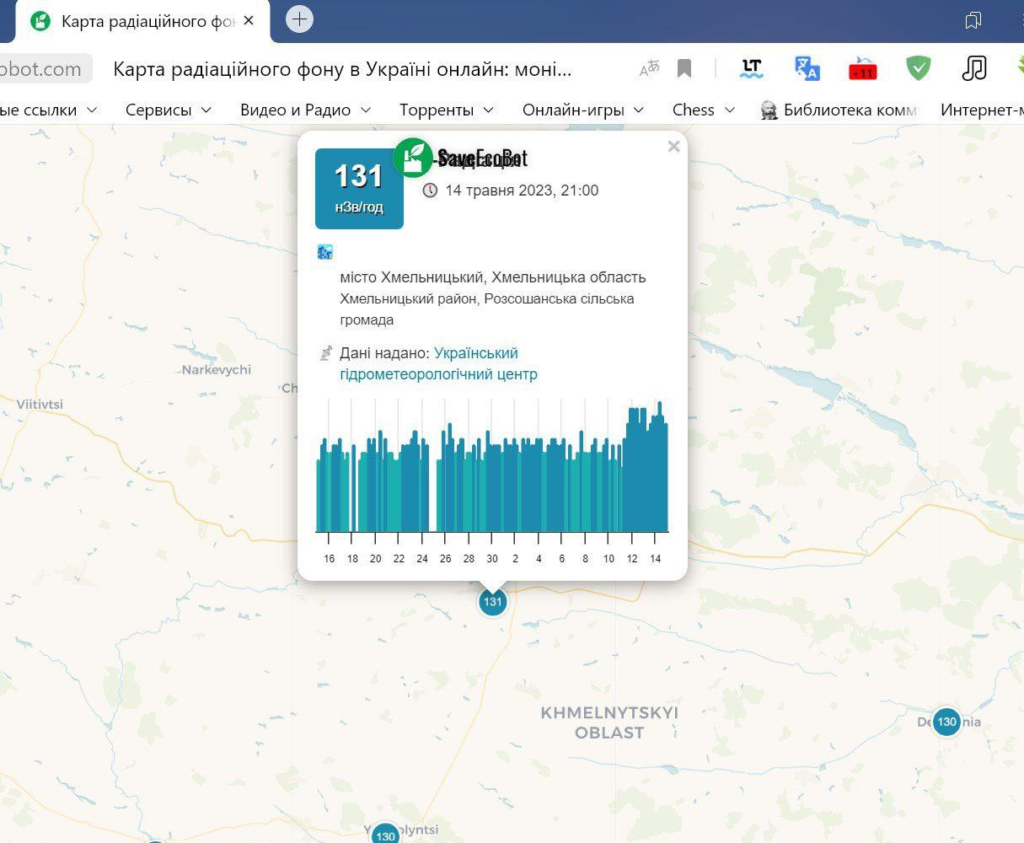Original article (in Bosnian) was published on 29/05/2023
The Russia Today Balkan channel published an incorrect claim suggesting there was an increase in radiation after the Russian attacks on a city in western Ukraine
On May 15, 2023, the Russian state media Russia Today Balkan published an article entitled:
Russian kamikaze destroyed British missiles with depleted uranium (VIDEO)
The article claims that on May 13, 2023, Russian forces bombed an ammunition warehouse in the city of Khmelnytskyi in western Ukraine. After the attack, the article states, there were “panic reports” that a weapons depot containing depleted uranium had been hit during the strike.
Already on May 14, panic reports began to spread on Ukrainian social networks that a large amount of British tank ammunition with depleted uranium, which was recently delivered to Ukraine together with “Storm Shadow” missiles, was destroyed during the detonation of an ammunition warehouse in Khmelnytskyi, journalist Sergej Karnaukhov reported.
The attack on the warehouse with this type of ammunition, the article claims, led to increased radiation, which was recorded by “specialized resource saveecobot.com”.
The information that there was British ammunition with depleted uranium in Khmelnytskyi has not yet been confirmed, but the specialized radiation monitoring resource saveecobot.com recorded an increase in gamma radiation from 80-100 to 140-160 nanosieverts. Given that depleted uranium emits a relatively small dose of gamma radiation, the current increase indicates that very large stocks of ammunition were destroyed, which released uranium dust into the air. (…)
Articles with these claims were published by 19 web portals from Bosnia and Herzegovina, Serbia and Montenegro, with only slight variations in the titles (1, 2, 3).
What are the facts about the attack on Khmelnytskyi?
The Russian armed forces indeed attacked the city of Khmelnytskyi in western Ukraine on May 13, 2023. According to reports from world media, such as CNN, 21 people were injured in the attack. According to the statements of local officials, according to CNN, “educational, medical and cultural institutions, administrative buildings, industrial facilities, multi-story buildings and individual residential buildings were especially damaged” in the attack.
In an article published on May 13, 2023, The Kyiv Independent reported that Russian forces attacked “critical infrastructure”, without specifying whether it was an ammunition warehouse at all. In the article from May 14, 2023, published by Business Insider, Russian authorities claim to have destroyed an “ammunition storage facility and a hangar at the air base”, while Ukrainian official sources state that “critical infrastructure” was attacked.
Thus, in the official statements after the attack on May 13, 2023, neither Russian nor Ukrainian sources even mentioned depleted uranium. The only thing specified about the attack is that it was carried out by drones, which Business Insider reports:
(…) According to reports, a wave of 21 drones was fired at the city.
“Unfortunately, not all drones were destroyed that night – 17 out of 21 drones. Four hit the Khmelnytskyi region”, Yuriy Ikhnat, a spokesman for the Air Force of the Armed Forces of Ukraine, told Mail Online. (…)
Our partner web portal from Montenegro Raskrinkavanje (.me) also verified the accuracy of the claim that Russian forces destroyed a warehouse of depleted uranium ammunition during the attack on Khmelnytskyi. As stated in the analysis published on May 17, 2023, there is no evidence that during those attacks the storage of ammunition with depleted uranium was destroyed.
Raskrinkavanje (.me) clarifies in an analysis that these false claims are part of a broader disinformation narrative about Ukraine as a nuclear power.
The narrative about nuclear weapons in Ukraine comes after the meeting of the President of Ukraine, Volodymyr Zelensky, with the Prime Minister of Great Britain, Rishi Sunak, who promised that the country would send more weapons to Ukraine. Previously, there were talks of anti-tank ammunition that the British said they would send to the Ukrainians, which contains depleted uranium. This “set off alarms” in the Kremlin, but experts say that such “missiles retain some radioactive properties, but cannot cause a nuclear reaction like a nuclear weapon would”.
Although the analyzed articles state that the claims of an attack on a weapons depot with depleted uranium have not been confirmed, it is further claimed that an increased level of radiation has been recorded.
Did the level of radiation increase in Ukraine after the attack on Khmelnytskyi?
Claims that an increase in radiation levels was recorded after the Russian attack were denied precisely on the web portal’s Twitter account, which was cited as the source of these claims. In the tweet of the SaveEcoBot profile, published on May 15, 2023, it is stated that claims about increased radiation are fake news and that radiation levels are within normal limits.
Yesterday evening, Russian propaganda began to spread fake news about the increase in radiation levels at the sensor in Khmelnytskyi. We also checked these measurements on nearby sensors – all values do not exceed normal levels. The radiation situation in Ukraine is normal.
Allegations of increased radiation levels were checked by other fact-checking platforms, such as Newsweek and StopFake in analyzes published on May 15, 2023. StopFake states that it is Russian propaganda and that these false allegations first appeared on Telegram channels and Twitter.
(… ) “It started through small Telegram channels and a propaganda Twitter account. They stated that ‘tactical nuclear munitions or those with depleted uranium went into effect in Ternopil and Khmelnytskyi.’ (…) Propagandists also ‘assured’ that ‘after the strike, ammunition for Leopard and Marder tanks was destroyed’, and depleted uranium is mentioned again”, writes the Center for Strategic Communications (…)
In the same analysis, StopFake notes that allegations of increased radiation levels were denied by the City Council of Khmelnytskyi, as well as by the mayor of that city, Oleksandr Symchyshyn. Newsweek states that the International Atomic Energy Agency (IAEA), an autonomous agency operating within the United Nations, confirmed that there was no increase in radiation in Ukraine.
On May 16, 2023, the media in Serbia reported that the Directorate for Radiation and Nuclear Safety and Security of that country announced that there is no official confirmation of allegations of increased radiation and that all available data do not show any elevated levels.
Director of the Directorate Sladjan Velinov announced that he is personally attending a regular international meeting at the headquarters of the International Atomic Energy Agency in Vienna and that he can say with certainty that there is no information about an increase in the level of radioactivity in Ukraine.
In addition, Newsweek explains in the mentioned analysis that the claims about the increased level of radiation are based on an incorrect interpretation of the data from the measuring stations. Namely, as proof of these claims, different photos are attached in different articles, and one of them looks like this:

Photo: Printscreen/Stanje stvari
However, Newsweek explains that a slight increase in radiation was recorded, but that it occurred 48 hours before the attack, not after the attack, as claimed. After the attack, radiation levels actually began to drop, suggesting that the Russian attack could have had nothing to do with it.
(…) So, for example, the graph used in the Gateway Pundit report and in other tweets appears to show a sharp jump in radiation levels, but the actual increase, according to EC data, begins on May 11, 2023, at least 48 hours before the missiles hit area (at which point the radiation level actually started to drop slightly).
Furthermore, changes in radiation levels appear to be quite small, peaking at about 155 nanosieverts per hour (compared to the 165 nSv/h recorded in Kharkiv on May 8 or almost t500 nSv observed near the Chernobyl exclusion zone over the past week).
As Newsweek concludes in the analysis, apart from the claims about increased radiation levels being incorrect, there are no official sources or credible reports that would confirm that British missiles with depleted uranium were destroyed in the Russian attack. Available sources indicate that a drone attack did take place and that the Russian authorities claim that an ammunition warehouse was attacked, without specifying its type. The Ukrainian authorities, on the other hand, state that “critical infrastructure” was damaged, without further details.
In accordance with the stated facts, we assess the claims that an increase in the level of radiation was recorded in Ukraine after the Russian attack on Khmelnytskyi as disinformation.
We assess the claim that the Russian attack on the Ukrainian city of Khmelnytsky damaged a weapons warehouse with depleted uranium as manipulation of facts.



